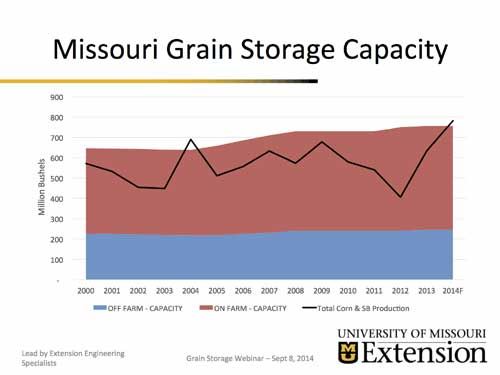|
Bumper Crop Exceeds Storage
COLUMBIA, MO.
University of Missouri Extension offers farmers help and options to store and dry 2014’s bumper corn crop.
MU Extension’s website lists guides and customized spreadsheets to help producers make decisions about storage options, said Joe Zulovich, extension agricultural engineering specialist. Ag specialists in extension offices across the state have undergone training recently to help farmers decide how and when to store, dry and transport grain.
Access charts, spreadsheets and guides at http://extension.missouri.edu/grainstorage.
The U.S. Department of Agriculture predicts the U.S. will produce 14.03 billion bushels of corn despite 4 percent fewer acres planted this year. USDA lists 83 percent of Missouri’s corn crop in good to excellent condition. The nation’s crop is the highest in 20 years for August thanks to a nearly perfect growing season.
USDA predicts corn prices at $3.25 per bushel, less than half of the $8 per bushel price of 2012. Low prices make it critical to keep costs and waste low, Zulovich said. Farmers must calculate whether and how to store on- or off-farm, and the cost of drying and transporting to a commercial facility.

Graph: Missouri grain storage capacity, 2000-present.
Credit: University of Missouri Extension
Leaving corn in the field is one way to store corn, said MU Extension natural resource engineer Frank Wideman and echoed by MU Extension economist Ray Massey. Some studies show minimal losses when corn is left to stand in the field for later harvest, Wideman said.
Massey recommends an economic analysis tool for determining the cost of drying grain. The tool helps farmers examine the value of commercial storage and drying when corn prices are low. Factors include grain moisture at harvest, target moisture for storage or marketing, cost of fuel for drying and commercial drying charges. Go to http://crops.missouri.edu/machinery/GrainDryingAid.xlsx.
“Drying out in the field may be a wise financial decision (this year),” he said.
Zulovich said farmers should weigh what type of on-farm storage to use – conventional grain bins, storage bags or temporary flat storage in modified buildings or well-maintained covered piles.
Some farmers plan to use machine sheds for temporary storage, but the sheds cannot hold grain safely without being retrofitted with grain storage walls inside the building walls. Dry grain can be stored outside within concrete blocks stacked no higher than three blocks. Provide a granular base or concrete pad floor and line floor and walls with a 6-mil plastic vapor barrier if concerned about moisture wicking into grain. Cover grain with a tarp. Concrete road barriers and commercial wall barriers also may be used for outside storage walls. Temporary storage is best limited to two months when there is no aeration. Aerated covered piles in well-drained outside areas may allow grain to be stored up to six months.
Aeration allows for longer storage, said specialist Jim Crawford. Keep piles small, low and dry. MU Extension’s website offers a variable grain volume estimator to help farmers estimate storage amounts.
Cost and availability of permanent on-farm and temporary storage options should be considered, said specialist Charlie Ellis. Producers must decide whether to dry corn naturally or by heat.
The bumper crop will take longer to haul, dry and store than in past years, Ellis said. A farm with 1,000 acres could produce up to 30,000 more bushels of corn, he said.
Rain, mud and high dew points may delay and limit opportunities for harvest, said specialist Frank Wideman. Commercial elevators likely will not be able to handle extra storage and drying requests.
Farmers should calculate cost of drying corn to levels of approximately 15.5 percent for storage. Extension website resources allow farmers to plug in corn moisture content and bin size to predict natural drying time.
Specialist Kent Shannon said airflow charts help farmers with drying strategies. They can decide if they have proper fans for sufficient airflow and pressure for bin size. ∆
|
|